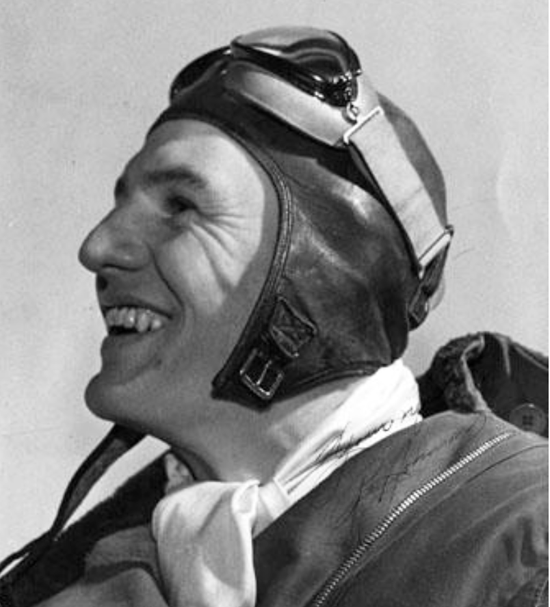
By James Chilton | Wyoming Tribune
(Editor’s note: Rose Law Group Reporter Editor Phil Riske is the eldest son of Raymond Johnson.)
CHEYENNE — When Raymond A. Johnson was born in Laramie in 1912, aviation was still very much in its infancy, with the Wright brothers’ flight at Kitty Hawk, N.C., having happened just a decade earlier.
But as aviation took off, Johnson was there with it every step of the way.
This week, Johnson was announced as the latest inductee into the Wyoming Aviation Hall of Fame. And as far as pilots go, Johnson did it all, from barnstorming and crop dusting to testing military jets and serving as one of the first pilot instructors for the U.S. Air Force.
Founded in 1994, the Wyoming Aviation Hall of Fame only has 21 inductees, with Johnson bringing the total to 22. Hall of Fame President John Waggener said only one person is added to the Hall of Fame each year.
“It does give more prestige to the individual inductees,” Waggener said. “We have about 30 nomination packets right now, and some of them probably will never be inducted; others, it’s only a matter of time.”
Johnson’s packet was originally submitted by a coworker in the mid-1990s, more than a decade after his death in 1984. But it was only recently that Waggener said the packet was rediscovered, and he reached out to Johnson’s family for further information.
He found Dicksie May, Johnson’s niece, who grew up in his household. May, herself a historian, was able to pull together a large amount of documentation of Johnson’s career as a pilot, which began when he was just 16 years old.
“He had to get a special license to be able to start flying at the age of 16,” May said. “The man that taught him how to fly was actually the first pilot in Albany County, and his name is Fred Wahl. He brought the first airplane into Albany County and had the first flight training business.”
Johnson made his first of many solo flights when he was 17, and began a lifelong love affair with aviation. His early career included flying with some of the first commercial airline services in the Mountain West, including Mountain Airways, Inland Airways, Plains Airways and Cheyenne Flying Service.
“Back in those days, the airplanes might have a few people on them, but they also had mail contracts, so to haul airmail was a big part of that commercial aviation,” Waggener said. “One of the neat things is that he was this Wyoming kid who just had a fascination with aviation from boyhood.”
In the late 1930s, Johnson won one of the first air races held in Cheyenne. He also served as a pilot for George Hopkins, who attempted to break the world record for most skydives in a 24-hour period, and famously parachuted onto Devils Tower National Monument in October 1941.
“(Johnson) was not the pilot for that flight; (Hopkins) had done that jump two weeks before he wanted to set this parachute record, something like 30 jumps in 24 hours,” Waggener said. “He made 13 jumps, and at 13 he just couldn’t go anymore.”
During World War II, Johnson served as a test pilot for North American Aviation in Kansas City, conducting test flights for new models of aircraft for the Army Air Forces. He went on to work as the chief pilot for a new collegiate training class at the University of Wyoming, then as a flight instructor at Columbus Air Force Base in Mississippi, where he trained pilots during the Korean War.
“A lot of pilots in World War II had very little training, but the pilots going into Korea had a bit more experience under their belt, and he was instrumental in training some of those pilots,” Waggener said. “He was there when they were switching from piston engine aircraft to jet aircraft, so he literally was training pilots on Monday on piston aircraft and on Tuesday in jet aircraft.”
May said her uncle didn’t just take the transition in stride. He was ecstatic.
“He was thrilled that he got to fly a jet. He felt like that was the ultimate thing to happen to him,” she said. “He became a flight commander almost immediately after he was hired.”
In fact, May recalls Johnson was never happier than when he was in the air, whether it was helping to train new pilots, or whether it was shuttling Wyoming Govs. Jack Gage and Cliff Hansen from one corner of the state to another.
“I remember one time his blood pressure went up a bit and they grounded him for a few days and he was totally devastated,” she said. “He loved flying. It was his first love; he ate, lived n everything was flying.”
Upon his return to Wyoming in 1960, Johnson became the safety and enforcement officer for the Wyoming Aeronautics Commission, the same commission that confirmed his nomination packet this month.
“That job would entail ensuring pilots are being properly trained and certified to work with airport managers and to make sure airports are being managed in a safe manner,” Waggener said. “I would say he’s pretty typical of inductees of this era in that he had some fairly early flight experience, he had some military experience and some commercial experience, then some administrative experience.”
But Waggener noted that while Johnson got to see aviation develop from a mere novelty into the global industry it is today, not many more future inductees may be able to make that same claim.
“Ray lived in the golden age of aviation. He not only witnessed it, he was part of it,” Waggener said. “But he’ll probably be one of the last of this World War II era. We’re starting to see a whole new range of pilots that include Vietnam pilots, big commercial pilots during the jet age, so we’re going to see some different types of nominations here in the next few years.”
A formal induction ceremony for Johnson will be held at a date yet to be determined, likely some time in mid-October. Afterward, his plaque and those of the other 21 Hall of Fame inductees will be on display at the Cheyenne Regional Airport terminal.











